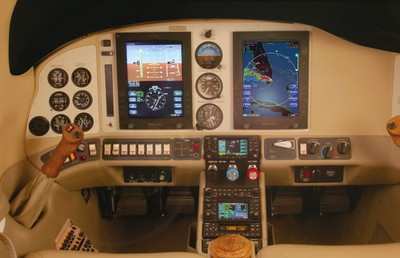Thu, Mar 12, 2009
Claims Plane's PFD Was "Defective And Dangerous"
 The family of a pilot killed in a February 2008 landing
accident has sued avionics manufacturer Avidyne, claiming the
accident plane's primary flight display was "defective and
dangerous"... despite a National Transportation Safety Board ruling
that pilot error was to blame.
The family of a pilot killed in a February 2008 landing
accident has sued avionics manufacturer Avidyne, claiming the
accident plane's primary flight display was "defective and
dangerous"... despite a National Transportation Safety Board ruling
that pilot error was to blame.
The Oregonian reports the $10.5 million wrongful death and
negligence suit was filed on behalf of the widow and three children
of Dr. Richard Otoski. The suit claims problems with the Lancair
Columbia 400's autopilot and attitude/heading reference system
(AHRS) were causal to the aircraft crashing while Otoski attempted
to make an ILS approach in hard IFR conditions to Portland
International Airport (PDX) on February 16, 2008.
As ANN reported, the pilot and sole occupant
was killed when the plane crashed alongside Runway 10-Right at PDX.
The aircraft was making its second approach to land in heavy fog
when it deviated from the approach path -- in an apparent attempt
to go missed -- and clipped a tree. The observed runway visual
range (RVR) was below IFR minimums at the time of the accident.
"The airplane's turn to the southeast was consistent with the
missed approach course of 160 degrees; however, a climb to 900 feet
is required prior to commencing the right turn, as outlined on
approach plate's missed approach instructions," reads the NTSB
Probable Cause report. "It appears the pilot likely misinterpreted
the missed approach instructions by making the right hand turn
prior to initiating a climb to 900 feet, which resulted in the
subsequent impact with the tree.

"...The airplane continued on the collision course before
impacting the ground in a left wing low, nose down attitude, about
845 feet from the initial impact point with the tree," continues
the report. "It then traveled through an airport perimeter fence
before coming to rest on a perimeter road in an upright position,
about 15 feet from the ground impact point."
Otoski was killed on impact. The Probable Cause report notes
"[n]o preimpact anomalies were found during an examination of the
airframe and engine. The airplane's avionics components revealed
that they were too thermally and impact-damaged to provide any
data." The Board's determination was the accident was due to "the
pilot's failure to follow the missed approach procedure.
Contributing to the accident were the fog and below landing
minimums visibility conditions."

Also named in the lawsuit is the former Lancair Certified
Aircraft -- later Columbia Aircraft Manufacturing Company -- which
is now owned by Cessna.
More News
The Industry Continues to be Rocked By Some Questionable Operations Recent investigations and a great deal of data has resulted in ANN’s SportPlane Resource Guide’s rep>[...]
Make Sure You NEVER Miss A New Story From Aero-News Network Do you ever feel like you never see posts from a certain person or page on Facebook or Instagram? Here’s how you c>[...]
Visual Approach Slope Indicator (VASI) An airport lighting facility providing vertical visual approach slope guidance to aircraft during approach to landing by radiating a directio>[...]
Airport Marking Aids Markings used on runway and taxiway surfaces to identify a specific runway, a runway threshold, a centerline, a hold line, etc. A runway should be marked in ac>[...]
Aero Linx: The Skyhawk Association The Skyhawk Association is a non-profit organization founded by former Skyhawk Pilots which is open to anyone with an affinity for the A-4 Skyhaw>[...]
 Unfortunate... ANN/SportPlane Resource Guide Adds To Cautionary Advisories
Unfortunate... ANN/SportPlane Resource Guide Adds To Cautionary Advisories ANN FAQ: Turn On Post Notifications
ANN FAQ: Turn On Post Notifications ANN's Daily Aero-Term (04.29.24): Visual Approach Slope Indicator (VASI)
ANN's Daily Aero-Term (04.29.24): Visual Approach Slope Indicator (VASI) ANN's Daily Aero-Term (04.28.24): Airport Marking Aids
ANN's Daily Aero-Term (04.28.24): Airport Marking Aids ANN's Daily Aero-Linx (04.28.24)
ANN's Daily Aero-Linx (04.28.24)





